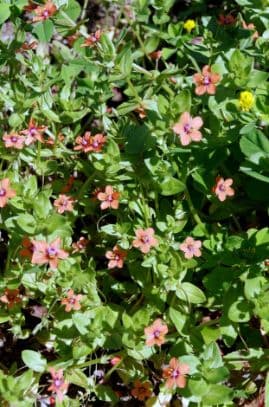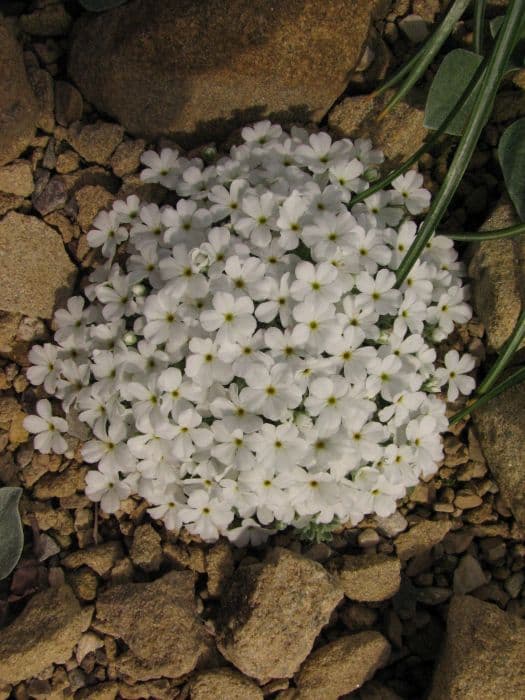Alpine Cyclamen Cyclamen purpurascens

ABOUT
Cyclamen purpurascens, commonly known as Alpine cyclamen or European cyclamen, is a perennial plant that is recognized for its distinct and ornamental appearance. The plant is characterized by its heart-shaped leaves which bear a beautiful pattern of green with silver marbling. Adding to its aesthetic, the foliage often has a purple hue on the underside, contributing to the plant's common name. The flowers of Alpine cyclamen are equally striking. They typically bloom in shades of pink, ranging from pale to a vibrant rosy hue. Each flower is comprised of five petals that are swept back dramatically, almost like the wings of a butterfly, and arranged in an upswept fashion giving them a refined and elegant look. At the center of the flower, there is a distinctive mouth with a color contrast, often appearing with a darker or lighter tone than the petals themselves. This plant's appearance makes it a favorite among gardeners and plant enthusiasts for its decorative quality and the charming touch it adds to the spaces it graces.
About this plant
 Names
NamesFamily
Primulaceae.
Synonyms
Eastern Cyclamen, European Cyclamen, Alpine Cyclamen, Purple Cyclamen.
Common names
Cyclamen europaeum, Cyclamen vernale, Cyclamen purpurascens var. immaculatum, Cyclamen purpurascens var. album
 Toxicity
ToxicityTo humans
Cyclamen, specifically Cyclamen purpurascens, contains toxic compounds such as saponins that can be harmful if ingested. If parts of the cyclamen plant are eaten, symptoms of poisoning can include nausea, vomiting, and diarrhea. In some cases, ingestion may also lead to abdominal pain. More severe reactions, though rare, can involve heart rhythm abnormalities and seizures if large amounts are ingested. Therefore, caution is advised to prevent accidental consumption, especially by children.
To pets
Cyclamen, particularly Cyclamen purpurascens, is also toxic to pets such as dogs and cats. The most toxic part of the plant is the tuber (root). If a pet ingests part of a cyclamen plant, symptoms can include salivation, vomiting, and diarrhea. In more severe cases, ingestion may lead to heart rhythm abnormalities, seizures, and even death. Immediate veterinary care is advised if a pet is suspected to have ingested any part of a cyclamen plant.
 Characteristics
CharacteristicsLife cycle
Perennials
Foliage type
Evergreen
Color of leaves
Variegated
Flower color
Pink
Height
6 inches (15 cm)
Spread
6 inches (15 cm)
Plant type
Bulb
Hardiness zones
5
Native area
Europe
Benefits
 General Benefits
General Benefits- Aesthetic appeal: Cyclamen purpurascens, also known as Eastern cyclamen, adds beauty to gardens with its vibrant flowers ranging from pink to purple and its heart-shaped leaves with distinctive patterns.
- Seasonal interest: Blooming in summer and early fall, it provides color and interest when many other plants have finished flowering.
- Shade tolerance: Eastern cyclamen thrives in shaded areas, making it ideal for woodland gardens or as an understory plant in shaded landscapes.
- Drought resistance: Once established, it is relatively drought-tolerant, requiring minimal watering and care.
- Attracts pollinators: The flowers produce nectar that attracts bees, butterflies, and other pollinating insects, benefiting the local ecosystem.
- Non-invasive: Unlike some ornamental plants, Eastern cyclamen doesn't aggressively spread, making it a good choice for controlled garden situations.
- Winter foliage: The leaves of Cyclamen purpurascens often stay green throughout mild winters, providing year-round ground cover and visual interest even in colder climates.
 Medical Properties
Medical Properties- This plant is not used for medical purposes.
 Air-purifying Qualities
Air-purifying QualitiesThis plant is not specifically known for air purifying qualities.
 Other Uses
Other Uses- Ornamental Display: Cyclamen purpurascens is often used for decorative purposes in gardens and homes due to its attractive foliage and colorful blooms.
- Symbolism & Gifts: The plant is sometimes given as a gift for special occasions such as Valentine's Day due to its heart-shaped leaves and association with love and tenderness.
- Floral Arrangements: The flowers of Cyclamen purpurascens can be used in floral arrangements to add a splash of color and a unique shape to bouquets.
- Container Gardening: Because of its compact size, it is well suited for container gardening and can add a touch of nature to balconies or patios.
- Fairy Gardens: The delicate and whimsical appearance of Cyclamen purpurascens makes it a popular choice for creating fairy gardens, enhancing the magical aesthetic.
- Educational Tool: The plant is used in educational settings to teach botany and horticulture, showcasing the life cycle of perennials.
- Fragrance Extraction: Although not as common, the scent of Cyclamen purpurascens flowers can be used to create perfumes or scented oils.
- Bonsai Art: Some enthusiasts use Cyclamen purpurascens in bonsai art for its beautiful leaves and the challenge of cultivating it in miniature form.
- Photography Subject: With its vibrant colors and patterns, the plant is a popular subject for horticultural photography and plant portraiture.
- Craft Projects: The dried flowers and leaves can be used in craft projects, such as making bookmarks, cards, or pressed flower art.
Interesting Facts
 Feng Shui
Feng ShuiThe Cyclamen is not used in Feng Shui practice.
 Zodiac Sign Compitability
Zodiac Sign CompitabilityThe Cyclamen is not used in astrology practice.
 Plant Symbolism
Plant Symbolism- Deep Love: The cyclamen flower is often associated with deep, lasting love, making it a popular gift for significant others, especially in the context of long-term relationships.
- Affection: Its sweet-scented blooms are symbolic of sincere affection and happiness, reflecting the warmth and comfort of a loving relationship.
- Goodbye and Parting: Cyclamen sometimes represents separation or saying goodbye, as it can also symbolize resignation or a farewell. It might be given to someone who is leaving or retiring.
- Maternal Love: The flower is also seen as a symbol of a mother's love, due to its nurturing and protective nature in how it cares for its seeds, akin to a mother's care for her children.
- Fertility and New Life: Both the appearance of the flower in spring and its ability to return each year imbue it with symbolism of fertility, renewal, and new beginnings.
 Water
WaterCyclamen, commonly known as Alpine Violet, should be watered when the top inch of soil feels dry to the touch, typically once a week. It's important not to overwater, as the tubers are prone to rot. Generally, give about 6-8 ounces of water, making sure to water the soil directly without wetting the leaves or the crown of the plant. During dormancy, after the leaves have yellowed and dropped, reduce watering to once every couple of weeks to keep the soil barely moist.
 Light
LightAlpine Violet thrives in bright, indirect light away from direct sunlight, which can scorch its leaves. The best spot is a north or east-facing window that provides filtered light. Sheltering it from the strong afternoon sun is crucial for its well-being.
 Temperature
TemperatureThe Alpine Violet prefers cooler temperatures, thriving between 60 and 70 degrees Fahrenheit. It can tolerate a short period of temperatures down to 50 degrees but should not be subjected to temperatures above 77 degrees Fahrenheit. Keeping it in a cooler room with good air circulation is ideal for this plant.
 Pruning
PruningPruning Alpine Violet is mainly for removing dead or yellowing leaves to maintain its appearance and health. This should be done after flowering, usually in late winter or early spring. It’s not necessary to prune regularly; instead, tidy up the plant whenever necessary to remove spent blooms and leaves.
 Cleaning
CleaningAs needed
 Soil
SoilAlpine cyclamen thrives in well-draining, loose soil with high organic matter. A mix of 1 part potting soil, 1 part perlite, and 1 part peat moss or leaf mold is ideal. Maintain a soil pH of 6.5-7.
 Repotting
RepottingAlpine cyclamen should be repotted every 1-2 years, using a pot only slightly larger than the previous to avoid excessively wet soil which can lead to rot.
 Humidity & Misting
Humidity & MistingAlpine cyclamen prefers moderate to high humidity levels, around 50-70%, but can tolerate lower humidity if not subjected to hot, dry air.
 Suitable locations
Suitable locationsIndoor
Keep Alpine cyclamen in cool, well-ventilated spaces with indirect light.
Outdoor
Place Alpine cyclamen in dappled shade with shelter from intense sun.
Hardiness zone
5-9 USDA
 Life cycle
Life cycleCyclamen purpurascens, commonly known as Alpine Cyclamen, begins its life cycle as a seed, which after a period of dormancy, germinates in the spring. The germination is followed by the emergence of a tuber, which serves as the plant's storage and regenerative organ. From the tuber, heart-shaped leaves unfold, providing photosynthesis to fuel growth. After the leaves have developed, the plant produces uniquely shaped flowers, usually in the summer or early autumn, ranging in color from pink to purple with a characteristic upward twist. Following pollination, which is often aided by insects, the flowers give way to seed pods that are gravity-dispersing; as the stems coil, seeds are brought close to the ground. The cycle completes when the plant enters a period of dormancy over winter, with the leaves dying back, and the cycle begins anew with the next growing season.
 Propogation
PropogationPropogation time
Late winter-early spring
Cyclamen purpurascens, commonly known as Alpine cyclamen, is typically propagated by seed. The optimum time for sowing seeds is in the late summer to early fall. To propagate the Alpine cyclamen by seed, one should first soak the seeds for 12-24 hours to soften the tough outer coating. After soaking, the seeds can be sown in a tray filled with a free-draining seed compost, lightly covering them with more compost. The tray should be kept at a temperature of around 68 degrees Fahrenheit (20 degrees Celsius) and out of direct sunlight. It's important to keep the compost moist but not waterlogged. Seedlings may take a month or more to appear and should be left undisturbed during this time. Once seedlings have developed a couple of sets of leaves, they can be carefully transplanted into individual pots.









